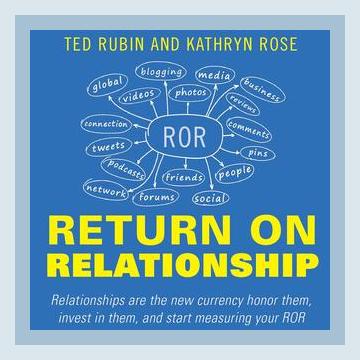Marketing and SalesCustomer Relationship Management
Title: Return On Relationship: Relationships Are The New Currency: Honor Them, Invest in Them
Authors: Ted Rubin & Kathryn Rose
Year: 2013
Category: Customer Relationship Management
Introduction
“Return On Relationship” by Ted Rubin and Kathryn Rose is a seminal work that underscores the importance of building and nurturing relationships in the modern business landscape. The authors argue that relationships are the new currency and provide practical insights on how businesses can foster meaningful connections with their customers, employees, and partners. This summary will encapsulate the core tenets of the book, enriched with concrete examples and actionable steps for implementation.
1. Foundations of Return On Relationship (ROR)
Major Point:
ROR is distinct from traditional ROI (Return on Investment); it is about the value accrued through nurturing human connections. Investing in ROR leads to long-term benefits that can’t always be measured in immediate financial terms but pay dividends in loyalty, advocacy, and business growth.
Example:
Ted Rubin explains how a tweet from a satisfied customer can reach thousands of people, thereby functioning as a valuable endorsement that is hard to achieve through conventional advertising.
Actionable Step:
Develop a customer engagement strategy that goes beyond transactions. Engage with customers on social media, respond to their comments and concerns, and show appreciation for their business.
2. The Power of Listening
Major Point:
Listening is a cornerstone of effective relationship building. It’s about genuinely understanding the needs, desires, and feedback from your audience.
Example:
Kathryn Rose recounts her experience with a small business owner who created a successful product line by actively listening to customer feedback and tailoring the products to meet those specific needs.
Actionable Step:
Implement feedback loops in your business operations. Regularly solicit customer opinions through surveys, social media, and face-to-face interactions. Use this feedback to make tangible improvements to your products or services.
3. Authenticity and Transparency
Major Point:
Authenticity and transparency foster trust. Being genuine and open with your audience can strengthen your brand and enhance customer loyalty.
Example:
Rubin cites the example of Domino’s Pizza and their “Pizza Turnaround” campaign, where they candidly shared customer criticisms and showcased their efforts to improve based on that feedback. This transparency led to a significant boost in customer trust and sales.
Actionable Step:
Embrace transparency in your communications. If there’s a mistake, openly acknowledge it and explain the steps you are taking to rectify it. Authenticity should be a core value in your customer service strategy.
4. Building Community
Major Point:
Creating a community around your brand is essential for cultivating lasting relationships. Communities allow for organic conversations, mutual support among members, and a stronger emotional connection to the brand.
Example:
The authors highlight Harley-Davidson’s ability to build a robust community of riders who share a deep sense of loyalty and belonging, which extends far beyond the mere purchase of a motorcycle.
Actionable Step:
Create forums, social media groups, or user events where your customers can interact not just with your brand, but with each other. Facilitate these interactions and contribute valuable content to these communities.
5. Social Media Dynamics
Major Point:
Social media is a powerful tool for building relationships, but it requires genuine engagement rather than broadcasting.
Example:
Rubin’s personal experiences of responding to every tweet and message, and the benefits he reaped from those engagements, underline his philosophy that every interaction is an opportunity to strengthen a relationship.
Actionable Step:
Establish a consistent and responsive social media presence. Respond to comments, participate in discussions, and showcase the people behind your brand to humanize your business.
6. Employee Relationships
Major Point:
Internal relationships with employees are just as crucial as external ones. Happy and engaged employees are more productive and serve as brand ambassadors.
Example:
Rose shares the example of Zappos, which invests heavily in employee satisfaction. Their commitment to company culture and employee happiness translates into exceptional customer service.
Actionable Step:
Invest in your employees. Provide ongoing training, recognize and reward their efforts, and foster a supportive and inclusive workplace culture.
7. Long-Term Vision
Major Point:
Building relationships is a long-term strategy that may not show immediate results but will lead to sustainable business growth.
Example:
The book mentions how Amazon, known for its relentless customer focus, continuously invests in improving the customer experience, knowing that this long-term investment will result in long-term loyalty and profitability.
Actionable Step:
Adopt a long-term perspective in your business strategies. Make decisions that prioritize customer relationships and experience, even if they incur short-term costs.
8. Metrics Beyond Money
Major Point:
While traditional metrics are important, businesses should also track metrics that indicate the health of their relationships, such as customer satisfaction scores, net promoter scores, and customer lifetime value.
Example:
Rubin points to Apple’s focus on customer satisfaction and loyalty. Their impressive retention rates and high customer satisfaction scores correlate strongly with their overall business success.
Actionable Step:
Incorporate relationship-focused metrics into your performance analysis. Regularly monitor these metrics and use them to guide relationship-building strategies.
Conclusion
“Return On Relationship” by Ted Rubin and Kathryn Rose is a compelling guide that shifts the focus from transactional to relational business approaches. The book emphasizes the intangible yet enormous value of nurturing relationships in various business aspects, including customer engagement, internal culture, and community building. By adopting the principles of ROR, businesses can achieve sustainable growth and differentiation in a crowded marketplace.
Actionable Summary Steps:
1. Develop a customer engagement strategy that prioritizes relationship-building.
2. Implement feedback loops to listen to and act upon customer needs.
3. Embrace transparency and authenticity in all communications.
4. Build a community around your brand for deeper customer loyalty.
5. Maintain a responsive and genuine social media presence.
6. Invest in the satisfaction and engagement of your employees.
7. Adopt a long-term vision focused on nurturing relationships.
8. Track and prioritize relationship-based metrics in your business analysis.
By following these principles, businesses can harness the new currency of relationships to unlock unprecedented levels of loyalty and growth.
